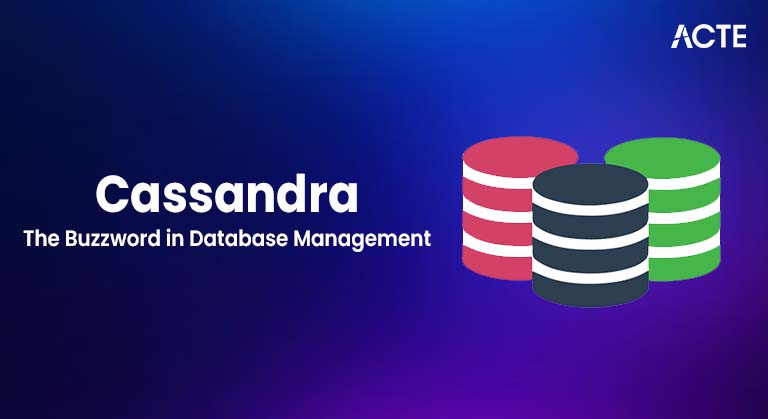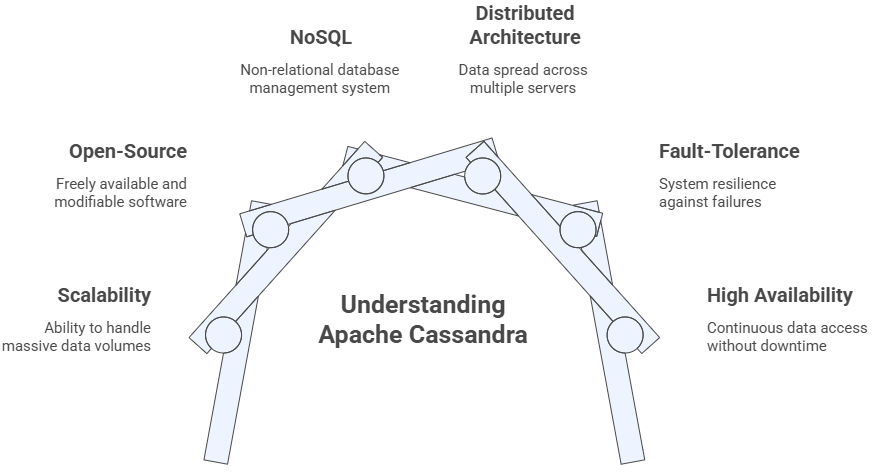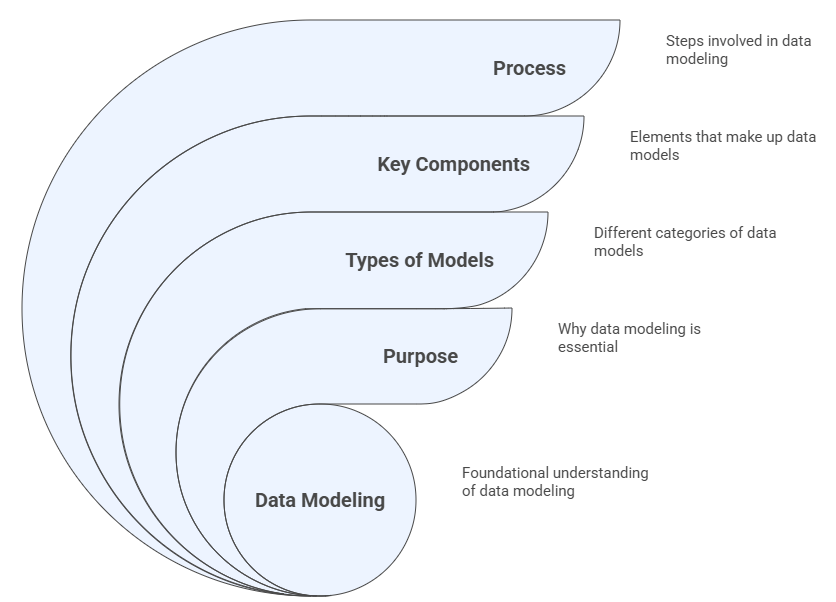
- Introduction to NoSQL
- What is Apache Cassandra?
- Features and Capabilities
- Architecture Overview
- Data Modeling Concepts
- Partitioning and Clustering
- Write and Read Path
- CAP Theorem and Cassandra
Introduction to NoSQL
NoSQL, short for “Not Only SQL,” has become a prominent buzzword in database management as modern applications demand more flexibility, scalability, and performance than traditional relational databases can offer. Unlike SQL databases that rely heavily on fixed schemas and structured query language, NoSQL databases support a wide range of data modeling concepts, including key-value pairs, document-oriented structures, wide-column stores. and graph models. This flexibility allows developers to build and adapt data systems quickly in response to changing application needs. A foundational concept that underpins NoSQL systems is the CAP Theorem, which states that in any distributed data system, only two out of the three Consistency, Availability, and Partition tolerance can be fully achieved at a time. This principle is a core topic in Database Developer Training, where learners gain a deep understanding of designing resilient and scalable database architectures. NoSQL databases often prioritize availability and partition tolerance, making them ideal for distributed environments. Among the popular NoSQL databases, Cassandra stands out for its ability to handle massive amounts of data across many commodity servers without a single point of failure. It is particularly suited for applications that require high availability, scalability, and fast writes. As businesses continue to embrace big data and real-time analytics, NoSQL databases are proving to be essential tools in the modern data infrastructure landscape.
Are You Interested in Learning More About Database Certification? Sign Up For Our Database Administration Fundamentals Online Training Today!
What is Apache Cassandra?
- Highly Scalable: Cassandra is designed to scale horizontally by adding more nodes to the cluster without downtime, making it ideal for growing datasets.
- Distributed Architecture: It distributes data across multiple servers using a peer-to-peer architecture, ensuring no single point of failure. This design is a key component of the Real-Time Big Data Converts Strategy, enabling organizations to achieve high availability and resilience in dynamic data environments.
- Supports High Availability: Cassandra provides high availability and disaster recovery through data replication, even across multiple data centers.
Apache Cassandra is a powerful, open-source non-relational database designed to handle large volumes of data across distributed servers with no single point of failure. Known for its scalability, high availability, and fault tolerance, Cassandra is widely used in applications that require real-time data access and durability. It stands apart from traditional relational databases and is often compared with other AWS NoSQL database solutions and tools like AWS MongoDB and Compass MongoDB.

- Flexible Data Model: Unlike relational databases, it supports a wide-column store model, offering flexibility in handling unstructured or semi-structured data similar to MongoDB Management Tool features.
- CAP Theorem Friendly: Cassandra leans towards availability and partition tolerance, making it highly resilient in distributed environments, like AWS MongoDB.
- Great for NoSQL Workloads: As a non-relational database, it competes with other AWS NoSQL databases and integrates well with modern NoSQL tools like Compass MongoDB for flexible, schema-free data management.
Features and Capabilities
Apache Cassandra offers a robust set of features and capabilities that make it a standout solution in today’s evolving database landscape, often cited as a leading buzzword in database management. Its distributed architecture is designed to handle large-scale data across multiple nodes without a single point of failure, ensuring high availability and fault tolerance. One of its most powerful strengths lies in its flexible data modeling concepts, which allow users to define data structures that align closely with application requirements, without being constrained by rigid schemas. Cassandra supports a wide-column store model, making it highly adaptable for handling both structured and semi-structured data. Understanding this flexibility is essential when exploring What Is Apache Cassandra, as it highlights the database’s ability to manage diverse data types efficiently across distributed systems. It also implements the principles of the CAP Theorem, prioritizing availability and partition tolerance over strict consistency, which is ideal for systems that require real-time performance and global distribution. With automatic data replication across nodes and data centers, Cassandra ensures reliability and resilience even in the face of hardware failures. Moreover, its support for tunable consistency levels gives developers control over the balance between data accuracy and system performance. Together, these features make Cassandra an exceptional choice for organizations seeking a powerful, scalable, and modern database solution that meets the demands of big data and cloud-native environments.
Are You Interested in Learning More About Database Certification? Sign Up For Our Database Administration Fundamentals Online Training Today!
Architecture Overview
- Peer-to-Peer Network: All nodes in Cassandra are equal, with no master-slave relationship, allowing each node to handle read and write requests independently.
- Partitioning and Token Ring: Cassandra uses consistent hashing to distribute data across nodes in a token ring, helping manage data efficiently in large clusters. This mechanism is often discussed in resources like What Is NoSQL Explained, where the focus is on how distributed databases ensure scalability, fault tolerance, and high performance.
- Replication Mechanism: Data is replicated across multiple nodes and even across data centers, ensuring high availability and fault tolerance.
Apache Cassandra’s architecture is designed to support high scalability, fault tolerance, and performance, making it a top buzzword in database management. Built on a peer-to-peer model, Cassandra eliminates single points of failure and distributes data evenly across all nodes. Its design adheres to modern data modeling concepts and aligns closely with the principles of the CAP Theorem, ensuring it meets the demands of distributed, high-availability systems. Below are six key components of its architecture:
- Gossip Protocol: Nodes use a lightweight gossip protocol to exchange information about themselves and other nodes, maintaining cluster health and communication.
- Memtable and SSTable Structure: Data is first written to an in-memory structure (Memtable), then flushed to disk as immutable files (SSTables), optimizing write performance.
- Tunable Consistency: In alignment with the CAP Theorem, Cassandra allows you to configure consistency levels per operation, offering flexibility between consistency, availability, and performance.
Data Modeling Concepts
Data modeling in a non-relational database like Apache Cassandra requires a shift in mindset compared to traditional relational models. Instead of focusing on normalization and complex joins, Cassandra emphasizes denormalization and query-driven design to optimize for performance and scalability. In modern applications, especially those using tools like AWS MongoDB, Compass MongoDB, and other MongoDB management tools, the focus is on how data will be accessed, not just how it’s stored. This approach to modeling ensures that queries are efficient, even at scale. With Cassandra, data is modeled around partition keys and clustering columns to define how data is distributed and sorted across the database cluster. These essential concepts are thoroughly covered in Database Administration Fundamentals Online Training, equipping learners with practical skills to design and manage scalable NoSQL databases effectively. This is particularly relevant in cloud environments where performance and availability are critical. Like AWS NoSQL databases, Cassandra supports flexible schemas that allow developers to evolve their data models with changing application needs. Using wide-column stores, developers can group related data together and minimize read times. Visual tools like Compass MongoDB have made designing and understanding such data models more accessible, even for those new to NoSQL systems. Overall, mastering data modeling concepts in NoSQL databases is key to building responsive, resilient, and scalable applications in the modern data landscape.

Partitioning and Clustering
Partitioning and clustering are core concepts in NoSQL systems like Apache Cassandra, enabling efficient data distribution and retrieval in a non-relational database environment. Partitioning involves distributing data across multiple nodes using a partition key, which determines the physical location of the data in the cluster. This approach is vital for maintaining scalability and high availability, especially in distributed systems such as AWS NoSQL databases. On the other hand, clustering defines the order of rows within a partition based on clustering columns, allowing for fast, sequential data access. This structure eliminates the need for complex joins and supports high-performance query operations. In comparison, platforms like AWS MongoDB and tools such as Compass MongoDB implement similar mechanisms to manage document distribution and indexing, though they follow a document-oriented approach rather than a wide-column model. When you Compare HBase vs Cassandra Database, these architectural differences become more evident, especially in terms of data modeling, consistency, and scalability in distributed environments. When using any MongoDB management tool, developers can visualize and refine partitioning strategies to improve performance, much like with Cassandra’s schema design. These partitioning and clustering techniques are essential for managing large datasets, minimizing latency, and ensuring horizontal scalability. As modern applications demand real-time performance and seamless scaling, understanding these principles in both Cassandra and other NoSQL solutions becomes crucial for effective database architecture.
Write and Read Path
The write and read path in Apache Cassandra plays a critical role in its performance and reliability, contributing to its status as a major buzzword in database management. When a write request is initiated, data is first written to a commit log for durability, then stored in an in-memory table called a memtable. Periodically, this data is flushed to disk as immutable SSTables. This write-optimized approach ensures high-speed performance and durability, even during large-scale data ingestion. A key aspect of managing such operations lies in Understanding Cassandra Keyspace, which defines how data is logically grouped and replicated across the cluster for efficiency and resilience. On the read path, Cassandra retrieves data from memtables and SSTables, using a Bloom filter and index to quickly locate the relevant data. Due to its data modeling concepts, Cassandra avoids complex joins and instead focuses on storing data in a way that aligns with specific query patterns, resulting in faster reads. Its architecture supports tunable consistency levels, allowing users to control the balance between consistency, availability, and latency key principles of the CAP Theorem. For instance, depending on the replication and consistency configuration, a read request might involve one or several nodes to ensure accuracy. Cassandra’s efficient read and write mechanisms make it ideal for applications requiring real-time access and scalable performance, further solidifying its place as a leading solution in distributed NoSQL systems.
Are You Preparing for Database Developer Jobs? Check Out ACTE’s DBMS Interview Questions and Answers to Boost Your Preparation!
CAP Theorem and Cassandra
The CAP Theorem is a foundational principle in distributed systems, stating that a database can only guarantee two out of three properties at any given time: Consistency, Availability, and Partition Tolerance. Apache Cassandra, a leading non-relational database, is designed to prioritize Availability and Partition Tolerance, making it ideal for large-scale, globally distributed applications. This design choice allows Cassandra to remain operational even when parts of the network fail or become unreachable, which is a critical feature in modern cloud environments like those supported by AWS NoSQL databases.While it sacrifices immediate consistency, Cassandra offers tunable consistency levels, enabling developers to adjust data accuracy based on application needs. This concept is thoroughly explored in Database Administration Fundamentals Online Training, helping learners understand how to balance consistency and performance in distributed systems. In comparison, systems like AWS MongoDB and tools like Compass MongoDB or any MongoDB management tool also grapple with CAP Theorem trade-offs but may prioritize different aspects depending on their use case. Cassandra’s architecture ensures that even under heavy load or node failures, read and write operations can continue with minimal disruption. This approach aligns with real-world requirements for performance, scalability, and resilience. Understanding how Cassandra interprets the CAP Theorem is crucial for developers and architects building mission-critical systems using NoSQL solutions across various industries and cloud platforms.


